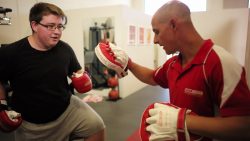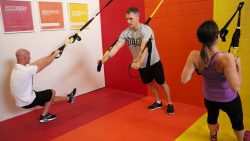With the 2018 Winter Olympics just finished and preparation for the 2018 Gold coast Commonwealth Games ramping up, you might find yourself wondering, how these athletes workout to get themselves in such peak condition. While we might not be aiming for quite the same level of performance as these elite athletes, there are several habits and training tips that can benefit a fitness program at any level.
 Nutrition and Hydration
Nutrition and Hydration
For professional-level performance and high levels of energy, you must eat properly to fuel your body. This means eating a breakfast of complex carbohydrates and lean protein, then small regular meals throughout the day, and a good dose of protein within 90 minutes of working out. Consume at least 2-3 litres of water per day, and more if you’re training hard or losing a lot of sweat in the heat. Good nutrition is your fitness foundation!
Sleep
Elite athletes that are training hard need 8-10 hours sleep every night. But even a non-athlete needs at least 7-8 hours in order to function properly during the day. Poor sleeping habits can actually prevent you from losing weight too! Improve the quality of your sleep by going to bed and waking at around the same time every day, don’t watch TV or other screens 30 minutes before bed – these can interfere with your sleep hormones and melatonin levels. Make your sleeping environment as dark and quiet as possible. Avoid the disruption of electromagnetic signals by turning off your wi-fi and phone before bed – or at least put your phone on flight mode.
 Proper warm-up
Proper warm-up
To prevent injury and improve performance, a dynamic warm-up is crucial before a maximal effort in a workout. This helps to increase heart rate, respiration rate, core temperature and optimise muscle length to prepare for the high-intensity effort. Spend a few minutes with light cardio gradually increasing intensity. Include dynamic stretches for all your major joints and muscle groups, as well as low-intensity versions of the main movements in your session eg) leg day – perform bodyweight squats, lunges and step-ups in the warm-up.
Proper cool down, stretch and recovery
When you have completed a high-intensity workout it’s important not to go from 100% to 0% right away – as your heart is pumping at maximum speed, blood is circulating through the body very quickly and the contracting muscles help push the blood back up through the veins. If you stop suddenly it places an enormous amount of stress on the heart and can cause blood pooling, dizziness and even trigger cardiac events. You need to taper the intensity down slowly as the heart rate gradually slows down. Include decreasing levels of activity, finishing off with low-intensity floor work. After your workout, incorporate recovery techniques like foam rolling, massage and static stretching to maintain or improve muscle flexibility and reduce pain and soreness.
Mental Preparation
High-level athletes spend a lot of time psychologically preparing for the big day. Some ways to do this are just as valuable for the rest of us non-athletes achieving fitness goals. Have a positive outlook and attitude towards training and life in general. Practice positive mental imagery where you imagine yourself performing or achieving your goal. Read inspirational books and quotes to uplift and inspire. Rehearse positive mantras and positive self-talk – it’s amazing how much your mind controls what your body can achieve. Have good tools to manage stress and anxiety.
Hire a coach
Great athletes have coaches. In order to get themselves the best performance, athletes know that a qualified and experienced coach will provide motivation, accountability, a structured approach to training and preparation, with a high level of expertise and knowledge that you just can’t get yourself. No matter how much you know, or what level you are training at, you get better and faster results with a certified coach.
Use functional training
Instead of using fixed-pieces of equipment, athletes use a huge variety of innovative pieces of equipment and training techniques to mimic the real-life movements of their sport. This is beneficial to anyone who wants to burn more calories in less time, incorporate their core and balance, and move their body in a fashion closer to the real-life movements they perform in a day. Things like medicine balls and fit balls, suspension training, agility ladders and hurdles, boxing and resistance bands. Integrating diagonal and rotational movements, unilateral exercises, explosive movements, running, jumping and throwing. More fun and more efficient types of training.
 Have a training buddy
Have a training buddy
Elite athletes will often train together for years leading up to the big events where they compete against each other. Accountability is a big part of success and when you train with a friend, partner, or in a small-group fitness class, exercise adherence increases. Training with friends makes a workout more enjoyable, and a healthy dose of competition can help you pick up the pace on those days you’re just not feeling it.
Have a goal
We know how important goal setting is for anything you want to achieve in life, without setting a real, tangible goal, your ideas are just that – ideas. An athlete will usually have a large goal – like competing in the Commonwealth Games, but they will have many smaller goals along the way – like achieving a certain time or level in their event, competing at a smaller level competition, making the qualification rounds etc. All of us non-athletes still need goals too. We need to set SMART goals, and we need to have them written down and made real in order to begin the journey.
Have a plan
A goal without a plan is just a wish. An elite athlete will have their training regime mapped out in cycles, aiming to peak their performance every 4 years for the big games, but also at certain intervals along the way like qualifiers and other international competitions. They will have each day, week, month and year completely mapped out with intensity, training focus, number of sessions and more. While we don’t all need to be QUITE so organised, this strategy has proven extremely important in helping anyone achieve a goal, especially those who need structure to stay on track. Make sure you have dedicated training days and times, and go in with a plan of attack. Every session should be step towards your ultimate goal. Make a plan today!

 Proper warm-up
Proper warm-up
 Have a training buddy
Have a training buddy